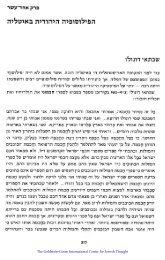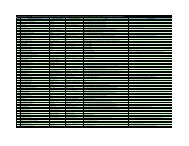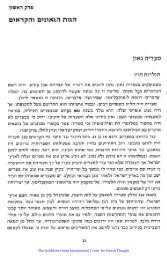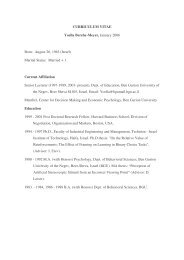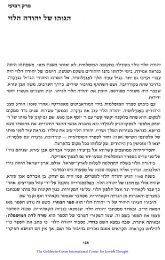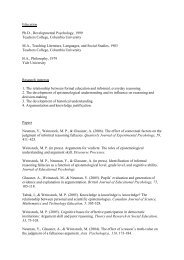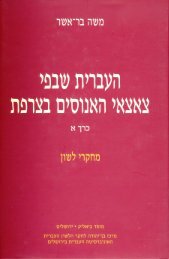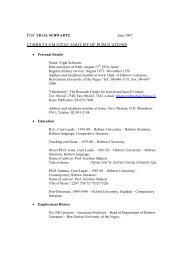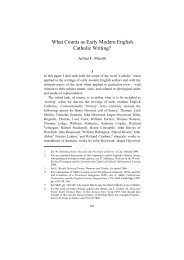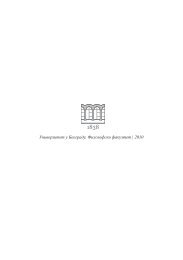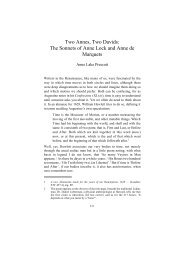Admiration and Disgust: The Ambivalent Re-Canonization of the ...
Admiration and Disgust: The Ambivalent Re-Canonization of the ...
Admiration and Disgust: The Ambivalent Re-Canonization of the ...
Create successful ePaper yourself
Turn your PDF publications into a flip-book with our unique Google optimized e-Paper software.
<strong>The</strong> <strong>Ambivalent</strong> <strong>Re</strong>-<strong>Canonization</strong> <strong>of</strong> <strong>the</strong> Zohar in <strong>the</strong> Modern Period<br />
repeatedly appears in descriptions <strong>of</strong> <strong>the</strong> Zohar during this period.<br />
Thus, for example, <strong>the</strong> writer Mendele Mokher Seforim, in his Be-‘Emeq<br />
ha-Bakha ('In <strong>the</strong> Valley <strong>of</strong> Suffering'; 1904), describes <strong>the</strong> Zohar as<br />
<strong>the</strong> pillar <strong>of</strong> fire illuminating <strong>the</strong> darkness <strong>of</strong> <strong>the</strong> Middle Ages:<br />
<strong>The</strong> Zohar is Sinai, <strong>the</strong> holy place, <strong>the</strong> mountain <strong>of</strong> God that<br />
strikes flames <strong>of</strong> <strong>the</strong> fire <strong>of</strong> love <strong>and</strong> sublime feelings <strong>of</strong> friendship.<br />
<strong>The</strong>re heaven <strong>and</strong> earth unite in a lover's kiss <strong>of</strong> <strong>the</strong> sons <strong>of</strong> God<br />
<strong>and</strong> <strong>the</strong> sons <strong>of</strong> man as <strong>the</strong>y embrace, <strong>and</strong> all <strong>of</strong> <strong>the</strong>m toge<strong>the</strong>r,<br />
<strong>the</strong> denizens <strong>of</strong> above <strong>and</strong> <strong>the</strong> denizens <strong>of</strong> below, sing praises to<br />
God with a sound <strong>of</strong> song <strong>and</strong> gratitude … <strong>The</strong> Zohar is <strong>the</strong><br />
pillar <strong>of</strong> <strong>the</strong> fire <strong>of</strong> love which first appeared to <strong>the</strong> children <strong>of</strong><br />
Israel in <strong>the</strong> darkness <strong>of</strong> <strong>the</strong> Middle Ages. 25<br />
Using similar language, but with greater emphasis on <strong>the</strong> religious <strong>and</strong><br />
mystical value <strong>of</strong> <strong>the</strong> Zohar, Hillel Zeitlin began his essay, 'An<br />
Introduction to Sefer ha-Zohar', published in <strong>the</strong> periodical Ha-Tequfah<br />
in 1920, as follows:<br />
What is <strong>the</strong> Zohar It is a sublime Divine soul that suddenly<br />
descended earthward from <strong>the</strong> World <strong>of</strong> Emanation, that it might<br />
be revealed to human eyes, with millions <strong>of</strong> lights <strong>and</strong> shadows,<br />
colors <strong>and</strong> varieties. <strong>The</strong> Holy One blessed be He took a precious<br />
stone from his crown <strong>and</strong> threw it down to earth, <strong>the</strong> stone burst<br />
<strong>and</strong> scattered, sowing thous<strong>and</strong>s upon thous<strong>and</strong>s <strong>of</strong> lights,<br />
rejoicing <strong>and</strong> laughing in multitudes <strong>of</strong> hues <strong>and</strong> tones, which<br />
came from Eternity so as to brighten all <strong>of</strong> <strong>the</strong> dark corners <strong>and</strong><br />
to satisfy whoever was thirsty <strong>and</strong> longed for <strong>the</strong> light, <strong>and</strong> to<br />
illuminate <strong>and</strong> warm whatever had been killed by <strong>the</strong> coldness<br />
<strong>of</strong> science <strong>and</strong> <strong>the</strong> darkness <strong>of</strong> ignorance, <strong>the</strong> blindness <strong>and</strong><br />
heaviness <strong>of</strong> nature, <strong>and</strong> <strong>the</strong> evil <strong>and</strong> difficulty <strong>and</strong> cruelty <strong>of</strong><br />
human beings. <strong>The</strong> Zohar was revealed to <strong>the</strong> people <strong>of</strong> Israel<br />
<strong>and</strong> to all <strong>the</strong> inhabitants <strong>of</strong> <strong>the</strong> earth through <strong>the</strong> influence <strong>of</strong><br />
pictures, parables, stories, epigrams, charming thoughts, <strong>the</strong><br />
heights <strong>of</strong> heavens, <strong>the</strong> deepest depths, <strong>the</strong> glory <strong>of</strong> <strong>the</strong> stars, <strong>the</strong><br />
25 Mendele Mokher Seforim, ‘Emeq ha-Bakha, Tel Aviv 1957, pp. 87-88.<br />
215



